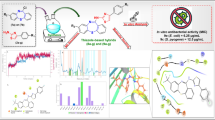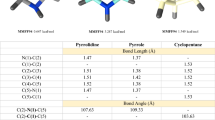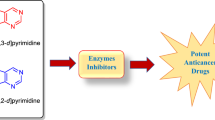Abstract
An experimental search for new benzimidazole derivatives with enhanced antiproliferative activity was successfully guided by QSAR modelling. Robust 3D-QSAR models were derived on an available database of compounds with previously measured activities. Our QSAR analysis revealed that an increase of the antiproliferative activities towards H460, HCT 116, MCF-7 and SW 620 cells will be obtained if new compounds are charged at a pH range from 5 to 7 and if their hydrophobicity is increased compared to the dataset compounds. Novel benzimidazo[1,2-a]quinolines bearing quarternary amino groups with corresponding aliphatic chains were designed, and their antiproliferative activities were computationally predicted. Using uncatalysed microwave-assisted amination reactions, 14 novel compounds were obtained to assess their antiproliferative activities towards H460, HCT 116, MCF-7, and SW 620 tumour cell lines in vitro. Novel compounds showed antiproliferative activities at micromolar and submicromolar inhibition concentrations. Experimental measurements of antiproliferative activities validation the QSAR models showing very good agreement between experimentally measured activities and computational predictions. In an attempt to elucidate the mode of action through which benzimidazole derivatives accomplish their antiproliferative activities, thermal denaturation experiments were performed to test their DNA-binding properties.
Graphical Abstract









Similar content being viewed by others
References
Silverman RB (2004) The organic chemistry of drug design and drug action, 2nd edn. Elsevier Academic Press, New York
Gaba M, Singh S, Mohan C (2014) Benzimidazole: an emerging scaffold for analgesic and anti-inflammatory agents. Eur J Med Chem 76:494–505. doi:10.1016/j.ejmech.2014.01.030
Shah K, Chhabra S, Shrivastava SK, Mishra P (2013) Benzimidazole: a promising pharmacophore. Med Chem Res 22:5077–5104. doi:10.1007/s00044-013-0476-9
Bansal Y, Silakari O (2012) The therapeutic journey of benzimidazoles: a review. Bioorg Med Chem 20:6208–6236. doi:10.1016/j.bmc.2012.09.013
Monforte AM, Ferro S, De Luca L, Lo Surdo G, Morreale F, Pannecouque C, Balzarini J, Chimirri A (2014) Design and synthesis of N1-aryl-benzimidazoles 2-substituted as novel HIV-1 non-nucleoside reverse transcriptase inhibitors. Bioorg Med Chem 22:1459–1467. doi:10.1016/j.bmc.2013.12.045
Ates-Alagoz Z, Yildiz S, Buyukbingol E (2007) Antimicrobial activities of some tetrahydronaphthalene-benzimidazole derivatives. Chemotherapy 53:110–113. doi:10.1159/000100011
Grogan HM (2006) Fungicide control of mushroom cobweb disease caused by Cladobotryum strains with different benzimidazole resistance profiles. Pest Manag Sci 62:153–161. doi:10.1002/ps.1133
Sharma MC, Sharma S, Sahua NK, Kohlia DV (2013) 3D QSAR kNN-MFA studies on 6-substituted benzimidazoles derivatives as nonpeptide angiotensin II receptor antagonists: a rational approach to antihypertensive agents. J Saudi Chem Soc 17:167–176. doi:10.1016/j.jscs.2011.03.005
Demeunynck M, Bailly C, Wilson WD (2002) In D.N.A. and R.N.A. Binders. Wiley, Weinheim
Rescifina A, Zagni C, Varrica MG, Pistarà V, Corsaro A (2014) Recent advances in small organic molecules as DNA intercalating agents: synthesis, activity, and modeling. Eur J Med Chem 74:95–115. doi:10.1016/j.ejmech.2013.11.029
Jeong J, Yoon J (2012) Recent progress on fluorescent chemosensors for metal ions. Inorg Chim Acta 381:2–14. doi:10.1016/j.ica.2011.09.011
Hranjec M, Kralj M, Piantanida I, Sedić M, Šuman L, Pavelić K, Karminski-Zamola G (2007) Novel cyano- and amidino-substituted derivatives of styryl-2-benzimidazoles and benzimidazo[1,2-a]quinolines. Synthesis, photochemical synthesis, DNA binding and antitumor evaluation, part 3. J Med Chem 50:5696–5711. doi:10.1021/jm070876h
Hranjec M, Pavlović G, Marjanović M, Kralj M, Karminski-Zamola G (2010) Benzimidazole derivatives related to 2,3-acrylonitriles, benzimidazo[1,2-a]quinolines and fluorenes: synthesis, antitumor evaluation in vitro and crystal structure determination. Eur J Med Chem 45:2405–2417. doi:10.1016/j.ejmech.2010.02.022
Perin N, Uzelac L, Piantanida I, Karminski-Zamola G, Kralj M, Hranjec M (2011) Novel biologically active nitro and amino substituted benzimidazo[1,2-a]quinolines. Bioorg Med Chem 19:6329–6339. doi:10.1016/j.bmc.2011.09.002
Perin N, Martin-Kleiner I, Nhili R, Laine W, David-Cordonnier MH, Vugrek O, Karminski-Zamola G, Kralj M, Hranjec M (2013) Biological activity and DNA binding studies of 2-substituted benzimidazo[1,2-a]quinolines bearing different amino side chains. Med Chem Commun 4:1537–1550. doi:10.1039/C3MD00193H
Perin N, Nhili R, Ester K, Laine W, Karminski-Zamola G, Kralj M, David-Cordonnier MH, Hranjec M (2014) Synthesis, antiproliferative activity and DNA binding properties of novel 5-aminobenzimidazo[1,2-a]quinoline-6-carbonitriles. Eur J Med Chem 80:218–227. doi:10.1016/j.ejmech.2014.04.049
Perin N, Nhili R, Cindić M, Bertoša B, Vušak D, Martin-Kleiner I, Laine W, Karminski-Zamola G, Kralj M, David-Cordonnier MH, Hranjec M (2016) Amino substituted benzimidazo[1,2-a]quinolines: antiproliferative potency, 3D QSAR study and DNA binding properties. Eur J Med Chem 122:530–545. doi:10.1016/j.ejmech.2016.07.007
Bertoša B, Kojić-Prodić B, Ramek M, Piperaki S, Tsantili-Kakoulidou A, Wade R, Tomić S (2003) A new approach to predict the biological activity of molecules based on similarity of their interaction fields and the \(\text{ log }P\) and \(\text{ log }D\) values: application to auxins. J Chem Inf Model 43:1532–1541. doi:10.1021/ci034063n
Zhuang XM, Xiao JH, Li JT, Zhang ZQ, Ruan JX (2006) A simplified model to predict \(P\)-glycoprotein interacting drugs from 3D molecular interaction field. Int J Pharm 309:109–114. doi:10.1016/j.ijpharm.2005.11.009
Fortuna CG, Barresi V, Berellini G, Musumarra G (2008) Design and synthesis of trans 2-(furan-2-yl)vinyl heteroaromatic iodides with antitumor activity. Bioorg Med Chem 16:4150–4159. doi:10.1016/j.bmc.2007.12.042
Ćaleta I, Kralj M, Marjanović M, Bertoša B, Tomić S, Pavlović G, Pavelić K, Karminski-Zamola G (2009) Novel cyano- and amidinobenzothiazole derivatives: synthesis, antitumor evaluation, and X-ray and quantitative structure-activity relationship (QSAR) analysis. J Med Chem 52:1744–1756. doi:10.1021/jm801566q
Bertoša B, Aleksić M, Karminiski-Zamola G, Tomić S (2010) QSAR analysis of antitumor active amides and quinolones from thiophene series. Int J Pharm 394:106–114. doi:10.1016/j.ijpharm.2010.05.014
Vujasinović I, Paravić-Radičević A, Mlinarić-Majerski K, Brajša K, Bertoša B (2012) Synthesis and biological validation of novel pyrazole derivatives with anticancer activity guided by 3D-QSAR analysis. Bioorg Med Chem 20:2101–2110. doi:10.1016/j.bmc.2012.01.032
Hranjec M, Lučić B, Ratkaj I, Kraljević Pavelić S, Piantanida I, Pavelić K, Karminski-Zamola G (2011) Novel imidazo\([4,5-b]\)pyridine and triaza-benzo[\(c\)]fluorene derivatives: synthesis, antiproliferative activity and DNA binding studies. Eur J Med Chem 46:2748–2758. doi:10.1016/j.ejmech.2011.03.062
Cruciani G, Pastor M, Guba W (2000) VolSurf: a new tool for pharmacokinetic optimization of lead compounds. Eur J Pharm Sci 11:S29–S39. doi:10.1016/S0928-0987(00)00162-7
Aleksić M, Bertoša B, Nhili R, Depauw S, Martin-Kleiner I, David-Cordonnier MH, Tomić S, Kralj M, Karminski-Zamola G (2014) Anilides and quinolones with nitrogen-bearing substituents from benzothiophene and thienothiophene series: synthesis, photochemical synthesis, cytostatic evaluation, 3D-derived QSAR analysis and DNA-binding properties. Eur J Med Chem 71:267–281. doi:10.1016/j.ejmech.2013.11.010
Aleksić M, Bertoša B, Nhili R, Uzelac L, Jarak I, Depauw S, David-Cordonnier MH, Kralj M, Tomić S, Karminski-Zamola G (2012) Novel substituted benzothiophene and thienothiophene carboxanilides and quinolones: synthesis, photochemical synthesis, DNA-binding properties, antitumor evaluation and 3D-derived QSAR analysis. J Med Chem 55:5011–5060. doi:10.1021/jm300505h
Kuethe J, Wong A, Davies I (2003) Rapid and efficient synthesis of 1\(H\)-Indol-2-yl-1\(H\) quinolin-2-ones. Org Lett 5:3975–3978. doi:10.1021/ol035541i
Cruciani G, Crivori P, Carrupt PA, Testa B (2000) Molecular fields in quantitative structure–permeation relationships: the VolSurf approach. J Mol Struct: THEOCHEM 503:17–30. doi:10.1016/S0166-1280(99)00360-7
Golmohammadi H, Zahra D, William EA Jr (2012) Quantitative structure-activity relationship prediction of blood-to-brain partitioning behavior using support vector machine. Eur J Pharm Sci 47:421–429. doi:10.1016/j.ejps.2012.06.021
De Maesschalck R, Delphine J-R, Désiré LM (2000) The mahalanobis distance. Chemom Intell Lab 50:1–18
http://dtclab.webs.com/software-tools. Accessed 08 Mar 2017
Acknowledgements
We greatly appreciate the financial support of the Croatian Science Foundation under the projects: 5596 (Synthesis and cytostatic evaluations of novel nitrogen heterocycles library), 5660 (A multidisciplinary approach to discover selective drugs targeting cancer stem cells: The role of potassium transport—MultiCaST) and IP-2014-09-7309 (SupraCAR).
Author information
Authors and Affiliations
Corresponding authors
Electronic supplementary material
Below is the link to the electronic supplementary material.
Rights and permissions
About this article
Cite this article
Vušak, D., Perin, N., Martin-Kleiner, I. et al. Synthesis and antiproliferative activity of amino-substituted benzimidazo[1,2-\({\varvec{a}}\)]quinolines as mesylate salts designed by 3D-QSAR analysis. Mol Divers 21, 621–636 (2017). https://doi.org/10.1007/s11030-017-9753-8
Received:
Accepted:
Published:
Issue Date:
DOI: https://doi.org/10.1007/s11030-017-9753-8




